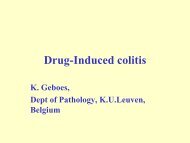Body Fluids - International Academy of Pathology
Body Fluids - International Academy of Pathology
Body Fluids - International Academy of Pathology
- No tags were found...
You also want an ePaper? Increase the reach of your titles
YUMPU automatically turns print PDFs into web optimized ePapers that Google loves.
<strong>International</strong> <strong>Academy</strong> <strong>of</strong> <strong>Pathology</strong> - Arab DivisionThe 24 th Congress Of The IAP-Arab DivisionKHARTOUM - SUDANArab School <strong>of</strong> <strong>Pathology</strong>Cytology workshopDecember 5-6, 2012
<strong>Body</strong> Fluid CytologyMousa Al-Abbadi, MD, FIACPr<strong>of</strong>essor <strong>of</strong> <strong>Pathology</strong> &CytopathologyKing Fahad Specialist Hospital – DammamSaudi Arabia
Cytology <strong>of</strong> effusions• Effusions are classified into:• Transudate: resulting from animbalance <strong>of</strong> hydrostatic and oncoticpressures. Ex. Congestive HF, cirrhosisand nephrotic syndrome.• Exudate: resulting from mesothelialinjury as in infections, lupus, RA,pancreatitis, radiation or malignancy.
Specimen processing• Fluid collected from the pleural cavity,peritoneal cavity or pericardium iscentrifuged.• An unfixed wet smear stained with toluidineblue is prepared to identify malignant cells.• 2 smears ( Diff quick and Pap) are prepared.• Cell block is prepared by adding plasma andthrombin. Immunostains can be performedon it.
WET PREPRMCSuspiciousAdenocarcinomaArabi & Al-Abbadi Acta Cytologica 2009
Benign effusions• Contain mesothelial cells, histiocytesand lymphocytes in varyingproportions.• Mesothelial cells can be sparse ornumerous. They’re usually dispersed.Binucleation and multinucleation arecommon. Mitosis can be seen. Lesscommonly they have cytoplasmicvacuoles.
Features <strong>of</strong> mesothelial cells• Often numerous• Usually dispersed as isolated cells• Occasional small clusters with windows• Round cells• Round nucleus• Single nucleolus• Dense cytoplasm with clear outer rim (lacyskirt).Kimura et al. Diagnostic Cytopathol 2009. Scoring System for MM (SSMM)
Mesothelial cells• Reactive mesothelial atypia can bestriking enough to raise the possibility<strong>of</strong> malignancy (MM or mets).• Spectrum <strong>of</strong> reactive atypia includingvariation in nuclear size, coarsechromatin, irregular nuclear contoursand very prominent nucleoli.Kimura et al. Diagnostic Cytopathol 2009. Scoring System for MM SSMM)
Mesothelial cells• Numerous clusters with 12 or moremesothelial cells is suspicious for MMeven if they’re not that atypical.Correlation with history, radiology andpleural biopsy is important.• In metastatic malignancy, twopopulation <strong>of</strong> cells are identifiedusually.
IMPORTANT MESSAGECLINICAL & RADIOLOGICALDATA ARE EXTREMELYIMPORTANT IN PARTICULARWITH NEW VIRGIN CASESWHERE MALIGNANCY (MM,CARCINOMA) IS HIGHLYSUSPECTED
CALRETININMOC-31
Differential Diagnosis• Reactive mesothelial cells• Metastatic carcinoma• This is one <strong>of</strong> the most challengingdiagnoses in fluid cytology resulting ina big dilemma.• Multiple studies have been done toresolve this issue using differenttechniques.
Other Benign Conditions•Histiocytes in serous effusions•Eosinophilic effusions•Lymphocytes in serous effusions•Rheumatoid effusions•Effusion in SLE
Histiocytes in Serous Effusion• In cancer, TB or pulmonary infarct• Difficult to distinguish from MC(transitional forms)• Usually single. Medium size but can vary• Indistinct cell border• Bean shaped eccentric nuclei, maybe bi ormultinucleate. Fine or dark chromatin• PAS -
In Pulmonary infarct
Histiocytes in Serous EffusionIn malignancy
Eosinophilic Effusions• At least 10% <strong>of</strong> WBCs areeosinophiles• 5-8% <strong>of</strong> pleural exudates,• Low risk <strong>of</strong> cancer• 1/3 have peripheral bloodeosinophilia• Charcot-Leyden crystals in ref.delayed samples• Long but self-limiting course
Eosinophilic Effusions• Idiopathic (most common)• Trauma (esp. pneumothorax)• Pulmonary infections• Pulmonary infarction• Hypersensitivity (asthma, RA, allergy, drug reaction, sarcoid)• Asbestos• Pleural tumors• Malignancies
Lymphocytes in Serous Effusions•Common in long standingconditions (in CHF)•Cirrhosis, nephrosis, RA, sarcoid,TB, viral, cancer•Benign lymphocytes developirregular nuclear membrane
Lymphocytes in EffusionIn CHFIn Metastatic carcinomaIn Sarcoidosis
Lymphocytes in SerousEffusionsIn Metastaticcarcinoma
Rheumatoid Effusion• Pleural, unilateral, more in men than women !!• Usually with active arthritis (independent <strong>of</strong>severity or duration)• Reflects the histology <strong>of</strong> Rheumatoid nodule• Necrotic debris (granular amorphous “fluffy”):pathognomonic.• The palisaded histiocytes appear spindle orcarrot-shaped (peculiar shapes)• Multinucleated cells• PMNs, lymphocytes. Rare or absent MCs!!!
Rheumatoid Effusion
Effusion in Systemic Lupus Erythematosus• Common, but late.Exudative• Predominance <strong>of</strong> PMNs orlymphocytes• LE cells: PMN ormacrophage containinghomogenous hematoxylinbody• LE cell not specific
Malignant effusionsMetastatic CarcinomasThe Most Common Tumors that CauseMalignant EffusionType <strong>of</strong> Malignant Men WomenPleural Lung BreastGastrointestinal tractPancreasLungOvaryPeritoneal GI (includes gastric) OvaryPancreasBreastProstateUterus
Metastatic Malignant Effusions(Pleural)• Second to CHF as a cause <strong>of</strong> effusions• Most <strong>of</strong> lung, breast, ovarian and GI• Direct: seeding <strong>of</strong> cells & irritation <strong>of</strong> serousmembranes. Tumor cells plentiful• Indirect: Postobstructive pneumonia,lymphatic obstruction, hypercoagulable state,reaction to Rx/Chx. tumor cells sparse• About 90% are ipsilateral to primary tumor
Metastatic Malignant Effusionsclues• A second tap may show more preserved cellsthan the first tap.• However, about 90% <strong>of</strong> malignant effusionsare diagnosed on first specimen• Atypia <strong>of</strong> inflammation resolves, but atypia <strong>of</strong>cancer persists• Adding Diff-Quik and cell block to Pap stainincreases sensitivity
Malignant Effusionsclues• Pleural metastases from abdomino-pelvicprimaries or breast usually indicate presence<strong>of</strong> liver metastasis.• Bilateral pleural effusion <strong>of</strong> lung cancer implypresence <strong>of</strong> liver metastasis• Malignant effusion indicates poor prognosis,• worse in peritoneal (weeks) than pleural(months) independent <strong>of</strong> number <strong>of</strong> cancercells (disseminated disease)
Metastatic Malignant EffusionsGeneral Cytologic Features• Foreign cells with foreign features(two cell population)• Cancers with small or large cells are easier torecognize/ diagnose than cancer with mediumsize cells• Sometimes, cancers (ovary & breast) producecells that mimic mesothelial cells• Psammoma bodies, can be also seen in benignconditions, mesothelial hyperplasia• Fibrin can trap cells false MC clumping
Malignant EffusionsGeneral Cytologic Features• Cell groups: clusters, balls, papillae, glands• Lymphoma, melanoma, sarcoma and somecarcinomas shed single cells• Groups have smooth outline (communityborder). Mesothelial groups have knobbyoutline• Individual tumor cells round up in fluid,monomorphic or pleomorphic.
Malignant EffusionsGeneral Cytologic Features• Cell surface sharp border, vs. fuzzy inmesothelial cells• Cytoplasmic secretory vacuoles vs.degenerative vacuoles• High N/C ratio, irregular nuclearmembrane and coarse chromatin aremost important• Atypical mitoses and macronucleoli
Pitfalls in Differential Diagnosis withCancer• No cancer Dx in degenerated cells• Cancer cells = cancer atypia• Cancer unlikely in transudate• Marked inflammation favors reactive• Clinical Hx important• Cytoplasmic mucin + : Adenoca• Definite acini or papillae: favor adenoca• Nuclear/ cytoplasmic stain:• Equal intensity : meso. cells• Darker nuclei : carcinoma• In equivocal cases: request 2 nd tap.
Adenocarcinoma• Most common malignant effusion• Increased N/C ratio, irregular nuclearmembrane, secretory vacuoles, 3-D clusters• Patterns: cell balls, papillae, glands, signetring,Indian-file, bizarre or giant cells• Cannonballs: breast, ovary and lung• Glands and Papillae: stomach/ colon, lung andovary• Signet ring cells: stomach, breast, ovary& lung
Adenocarcinoma3- D Clusters Pattern
Adenocarcinoma3- D Clusters Pattern
Gland Pattern
AdenocarcinomaMini-papillarypattern
Cell Balls
Single Cell
Single Cell Pattern•Mesothelioma•Melanoma•Lymphoma•Adenocarcinoma: lung, breast, gastric
Inflammatory- predominant
Signet Ring Cell Pattern
Benign MC mimicking cancerRMCRosettes/ cell ballsPapillaeIndian filesCell-in-cellSignet ring-likeSingle cellsMimicAdenocarcinomaPapillary adenocaBreast, SCCSq.c.c.Signet ring caCa, lymphoma,melanoma
Adenocarcinoma vs. reactive mesothelialcellsPleural fluid with metastaticbreast cancerReactive mesothelial cells in asciticfluid <strong>of</strong> patient with liver cirrhosis
Adenocarcinomavs. reactive mesothelialcells
Other Metastatic Carcinomas•Squamous cells carcinoma•Small Cell Carcinoma•Mucinous Carcinoma,Pseudomyxoma Peritonei
Squamous Cell Carcinoma• Rare in malignant effusions,
Effusion, Squamous Carcinoma
Small Cell Carcinoma• Cells are more variable in size/ shapethan mature lymphocytes• Some cell clusters, nuclear molding orIndian-files• Cells are round to angular.Hyperchromatic nuclei• D.Dx: breast, GI, small blue cell tumors(pediatrics).
Effusion, Small cell carcinoma
Effusion, Small cell carcinomaRMC
Pseudomyxoma Peritonei• Low grade tumor,slow but relentlessgrowth• Ovary, appendix,GI/pancreas• Thick mucin, sparsetumor cells incohesive sheets.Bland cells
Pseudomyxoma Peritonei
Peritoneal Washing Cytology• Staging GYN and other cancers (FIGO)• Detecting occult carcinomas (esp. ovary)• Document persistent/ recurrent cancer• Positive wash more likely have other poorprognostic factors (LN+, tumor spread)• If no ascites: washes <strong>of</strong> rt/ lt paracolicgutters, diaphragm and cul-de-sac.• False – high ~ 60%• False + high ~ 9%
Malignant Mesothelioma• Usually unilateral effusion, commonlybloody or the color and consistency <strong>of</strong>honey.• Cytologic features:• Large clusters with scalloped (knobby)edges.• Cytomegaly• Round, centrally placed nuclei• Prominent nucleoli
Malignant Mesothelioma• Binucleation and multinucleation• Dense cytoplasm with peripheral halo• Normal N/C ratio…but• Windows• Nuclear atypia is mild in most cases• Rarely, vacuolated cells and luminaformation can be seen.
Malignant Mesothelioma• Uncommon patterns:• Predominantly isolated tumor cells• Abundant lympho-histiocytic infiltrate• Psommoma bodies.• These can result in false negative Dx• IMPORTANT MESSAGE: NO SINGLE FEATUREIS DIAGNOSTIC…IT IS THE CONSTELLATIONOF MULTIPLE FEATURESKradin et al. Semin Diagn Pathol 2006 (review)Pereira & Silverman. Adv Anat Pathol 2006 (review)Bedrossian. Diagn Cytopathol 1998 (review)
Malignant Mesothelioma• Uncommon neoplasm that holds aprominent place in diagnosticpathology because <strong>of</strong> difficulty inestablishing definitive Dx, clinical andmedicolegal implications…1-8OO-MESOTHELIOMA• Incidence varies from country tocountry, 3000 cases/year in USA.• Age: 5-7 th decade.• 2:1 male to female ratio.
MalignantMesothelioma• Exposure to asbestos is the mostfrequent risk factor (80%).• 5% <strong>of</strong> people exposed develop MM.• Non asbestos-related causes includechronic pleural injurious agents(fibrous zeolite), radiation andhereditary factors.• 30 years latency to develop MM.
Malignant Mesothelioma• It is predicted that MM will beresponsible for 250,000 deaths acrossWestern Europe over the next 35 yearsbefore declining in incidence.• MM is an aggressive, almost universallyfatal neoplasm.• Most cases arise in the pleural cavity,peritoneal cases are 1/3 as common.Rare cases in the pericardium andtunica vaginalis testis.
Malignant Mesothelioma• Sx: insidious development <strong>of</strong> chest pain,dyspnea, weight loss and cough. Cancause recurrent effusion (usuallybloody).• Radiology: Pleural nodularity orthickening, usually with an effusion.• In the peritoneum Sx includeabdominal discomfort, distention andconstipation. Radiology showsperitoneal and omental thickening withascites.
Malignant Mesothelioma• Poor prognosis with a median survival<strong>of</strong> 18 months.• Peritoneal and pericardialmesothelioma have worse prognosis.• At present, MM is incurable. Anaggressive approach combining radicalsurgery (extra pleuralpneumonectomy), with adjuvant chemoand radiotherapy has improved overallsurvival.• New Rx modalities include immunetherapy and gene therapy.
Malignant Mesothelioma• Histologic subtypes: epithelial (60%),sarcomatous (15%), and mixed (25%).• Neoplastic cells range in morphology fromextremely bland to highly anaplastic.• Immunohistochemistry improves accuracyGreffe et al. Acta Cytologica 2008 (accuracy 74 to 94% by using 4 immunostains)Marchevsky Arch Pathol Lab Med 2008 (review)King et al. Histopathology 2006 (review)
Adenocarcinoma : MesotheliomaMOC-31CalretininCEA-pPodoplanin (D2-40)BerEp4CK 5/6TTF-1 (lung)Marchevsky & Wick. Appl Immunohistochem Mol Morphol 2007Bhala & Siddiqui. Diagn Cytopath 2007
Mesothelioma
BerEp4CALRETININCEA D 2 - 40
CBMOC-31CALRETININ
HISTOLOGY
Another case
CALRETININ EMA MOC-31D2-40Ber-Ep4
CALRETININD2-40
Another case
OTHER MALIGNANCIES
Lymphomas & Plasma cellmalignancies in body fluids• Small size lymphomas are the commonest• CLL/SLL• FL• MCL• DLBCL can be seen so are other lymphomas• Plasma cell neoplasm• Hodgkin’s lymphoma is very rare• Effusion lymphomas and HH8 lymphomas
Rule <strong>of</strong> thumb•MONOTONOUS SINGLECELLS•NEEDIMMUNOPHENOTYPICCONFIRMATION (FCM)Das DK. Diagn Cytopathol 2006 (review)Czader & Ali. Diagn Cytopathol 2003Stetler-Stevenson & Braylan. Semin Hematol 2001
Reactive T-Cells
FL in Pleural Fluid
CD 20 CD 10FL Minimal involvement 5%
CLL
DLBCLCD 20 CD 3
Plasmablastic lymphoma
Plasmablastic lymphoma
Primary Effusion Lymphoma (PEL)• HIV asociated• No mass or lymphadenopathy• HHV-8• Null immunophenotype• Bad px…survival in months• Variable morphology…commonly plasmacyticCrabone et al. Acta Hematol 2007 (review)
Cancer. 1989 Dec 1;64(11):2254-8.High-grade B-cell lymphoma presenting as polyserosal diseaseDiagnosis by flow cytometry.Moreb J, Duque RE, Siddiqui T, McCarley DL, Braylan RC.Department <strong>of</strong> Medicine, University <strong>of</strong> Florida College <strong>of</strong> Medicine,Gainesville.AbstractTwo patients presenting with anasarca were found to have aggressiveB-cell lymphoma. No bulky disease was detected. The diagnosis wasrapidly established by the flow cytometric analysis <strong>of</strong> cell surfaceimmunophenotype and cell cycle fractions <strong>of</strong> pleural or peritonealcells. Such presentation <strong>of</strong> lymphoma is unusual and previouslyundescribed, and it may have a significant negative prognostic impact.The authors' observations indicate that lymphoma be included in thedifferential diagnosis <strong>of</strong> anasarca and that flow cytometry can beuseful for a fast confirmation <strong>of</strong> the diagnosis.
HHV-8Cibas & Ducatman, 3 rd Edition
MELANOMA• Usually Hx. Of melanoma but…notalways• If pigmented, fluid dark• Ovoid cells and nuclei, binucleation,prominent nucleoli, inclusions• S 100, HMB-45 and Mart-1 on cell blockMurali et al. J Clin Pathol 2009
Melanoma
SARCOMA• Rare but can occur• Usually previous history is +ve• High grade sarcomas lung metsEffusion• Malignant spindle cells +/- bizarre cells• IMHx
Sarcoma
Role <strong>of</strong> Ancillary Studies in Diagnosis andClassification <strong>of</strong> Effusion Cytology• RMC vs. Adenocarcinoma• RMC vs. Mesothelioma• Confirmation <strong>of</strong> lymphoma: IHC, FCM• Diagnosis <strong>of</strong> metastatic malignancy• Classification <strong>of</strong> tumors <strong>of</strong> unknown primary• Special stains• IHC• Tumor markers, DNA Ploidy, cytogenetics, EM
IHC in Effusion Cytology• Most cases can be diagnosed based oncytomorphology. Few cases require ancillarystudies.• Tumors <strong>of</strong> Unknown Origin:• Breast: CK7, ER, GCDFP• Lung: CK7, TTF-1• Colon: CK20, CDX2• Renal: AE1/3, EMA, vimentin, CD10, RCC, PAX8• Prostate: PSA, PSAP• Small cell ca: chromogranin, synaptophysin, CD56• Melanoma: S100, Mart-1, HMB-45• Lymphoma: FCM study. CD3, CD20, CD45, CD5
Lung AdenocarcinomaTTF1CK7CEA
LymphomaCD20CD3
Breast CarcinomaGCDFPERCK7TTF1
Lung Ca. Single Cell PatternTTF1CEACK7
Reactive Mesothelial CellsCalretininBerEp4
Pitfalls in Effusion Cytology•False positive diagnoses (0.5%):•Endosalpingiosis, endometriosis•Lymphocytosis•Atypical, reactive MCs•Psammoma bodies•Collagen balls•Cell-in-cell
Pitfalls in Effusion Cytology• False Negative Diagnosis (up to 30%):• One population <strong>of</strong> single malignant cells:adenoca, melanoma, lymphoma,mesothelioma• Scanty malignant cells• Lymphocytic population, inflammatory:lymphoma• Failure to identify 2 nd population <strong>of</strong>malignant cells
Pitfalls ….• Beware <strong>of</strong> degenerative changes• Improper specimen processing• The many faces <strong>of</strong> RMC• Prior radio or chemotherapy• Always do careful screening, clinicalhistory & appropriate ancillary studies
Accuracy• In patients with pleural malignancy,cytologic examination <strong>of</strong> pleural fluid ispositive in 71% <strong>of</strong> cases compared topleural biopsy (45%), because fluidprovides a more representative sample.• False negative rate for effusion cytologyin general is 58%.• False positive is less than 1% <strong>of</strong> benigneffusion.
Accuracy• False positive and false suspiciousdiagnoses are caused by mesothelial cellatypia in the setting <strong>of</strong> pulmonaryinfarction, TB, chemotherapy, acutepancreatitis, ovarian fibroma, uremiaand cirrhosis.• Adjunct immunohistochemistry canhelp to improve sensitivity.
GOODLUCKAL-ABBADI








